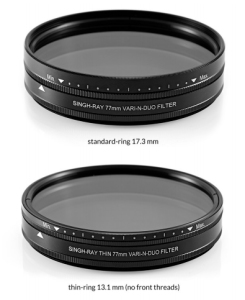 What does it do?
What does it do?
As its name suggests this screw-in filter polarises and reduces light transmission from 2 2/3 – 8 stops.
You can choose to have no, some or full polarising effect on your scene. The neutral density filter likewise can be set at the minimum about two and two third stops or all the way up to 8 stops both of these functions are completely flexible.
How do you use it?
Screw the filter onto your lens and line up the triangle on the first moving ring (1) (the one closest to the camera body) to the triangle next to the Min marker on the outer ring (2)(the one furthest away from the camera). Turn both filters together counter clockwise till the desired amount of polarisation is set, then turn the number 2 ring to change the amount of light coming into your lens.
Things to think about:
- turning the filters anticlockwise will prevent you from accidentally unscrewing it from your camera
- For best results use the front ring only between the Min and Max markings
- You can hand hold a graduated filter in front of your lens if necessary being careful not to move the camera – you may want to do this if a bright sky is dominating your scene
- When using the filter with a wide angle lens, you may have to adjust your focal length to reduce the vignetting (this is less on the THIN version of this filter but still occurs @ 17mm)
Applications:
Ideal for taking photos of waterfalls, rainforests, landscapes and seascapes etc.
Why would you use this and not your Lee filter or other mounted filter set up?
You may choose to use the Variable ND filter in situations where you’re crawling through low bushes or ducking under trees where a mounted filter is at risk of being pulled off. The screw in filter doesn’t get caught in the foliage its quick, easy to use and lightweight. Image quality is also good with no obvious colour casts or softness.
How much do they cost?
Singh-Ray direct in the USA – was $499.74 (incl postage)
Where can I buy one?
http://www.singh-ray.com
http://www.bhphotovideo.com
Photo credit: Singh-Ray.com
